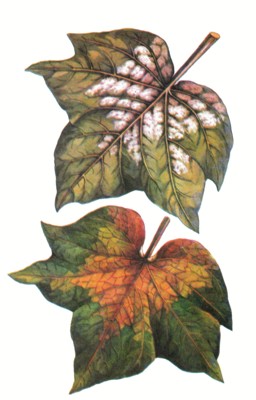Diseases
Leveillula taurica (Lev.) G.Arnaud. - Powdery Mildew of Cotton.
Systematic position.
Kingdom Fungi, phylum Ascomycota, class Ascomycetes, order Erysiphales, family Erysphaceae, genus Leveillula.Synonyms.
Oidiopsis taurica (Lev.) E.S. Salmon, Erysiphe taurica Lev., Ovulariopsis cynarae (Ferraris and Massa) Ciccar., Leveillula malvacearum Golovin. ( http://www.SpeciesFungorum.org ).Biological group.
Biotroph.Morphology and biology.
The causative agent of Powdery Mildew of cotton, the fungus Leveillula taurica develops in anamorphous and telemorphous stages in its life cycle. Its morphological structures are white, later gray or light brown, septate endophytic or exophytic mycelium, hyaline conidiophores with monocellular single conidia (28-42x14-22 mkm) of Oidiopsis type, hemispherical cleistothecia (135-240 mkm in diameter) with simple numerous appendages at base. Seven to 38 asci (75-100x28-40 mkm) are formed in each cleistothecium. There are two ascospores in one ascus, each 28-42x14-22 mkm in size. Formation of fungal cleistothecia occurs at telemorphous stage; in anamorphous stage the fungus forms the other morphological structures. The disease can usually be seen after the start of cotton flowering on the lower leaf side and then on upper one as white (mealy) fur. After a time the fungus sporulation becomes gray or light brown. Yellow necroses appear on the affected leaves. Sources of infections are conidia, mycelium in affected vegetation residues, and ascomata (cleistothecia). Weeds of the family Malvaceae can reserve the infection. During cotton vegetation the fungus forms several generations of conidia that provide intensive distribution of the disease. Fruit bodies or cleistothecia appear at the end of vegetation on thickened exophytic mycelium. In spring the cleistothecia form asci with ascospores serving as sources of primary infection of cotton. The infection can occur simultaneously from conidial sporulation being formed on mycelium that was kept in the affected vegetation residues.Distribution.
Powdery Mildew is spread on cotton everywhere in the countries of the former USSR.Ecology.
Fungus L. taurica is a typical xerophyte, adapted to dry and hot conditions. The pathogen affects cotton most intensively at high air temperature above 28°C and relative humidity about 25-30%. Under such extreme conditions, the causative agent keeps its high viability in anamorphous stage due to endophytic (endocellular) mycelium inside infected leaf tissues of cotton. The fungus affects long-fibrous (Gossypium hirsutum) and fine-fibrous (Gossypium barbadense) varieties of cotton.Economic significance.
At high severity the disease causes premature drying of leaves and sometimes defoliation; resulting yield losses of raw cotton up to 7%. Control measures are the use of resistant varieties, timely removal of weed-reservations of the infection, application of chemical protection at strong disease severity, after harvesting deep plowing of affected vegetation residues of cotton.Reference citations:
Gorlenko M.V. 1968. Diseases of cotton. Agricultural phytopathology. Moscow: Visshaya Shkola, 434 p. (In Russian).Gorlenko M.V. 1976. Order Erysiphales or Powdery mildew fungi (Erysiphales). In: Gorlenko M.V., ed. Fungi. Moscow: Prosveshchenie, V.3:132-144 (In Russian).
Peresypkin V.F. 1974. Diseases of cotton. In: Agricultural phytopathology. Moscow: Kolos, p. 189-212 (In Russian).
Peresypkin V.F. 1987. Parasitic diseases of cotton. Atlas of diseases of field cultures. Kiev: Urozhai, 144 p. (In Russian).


